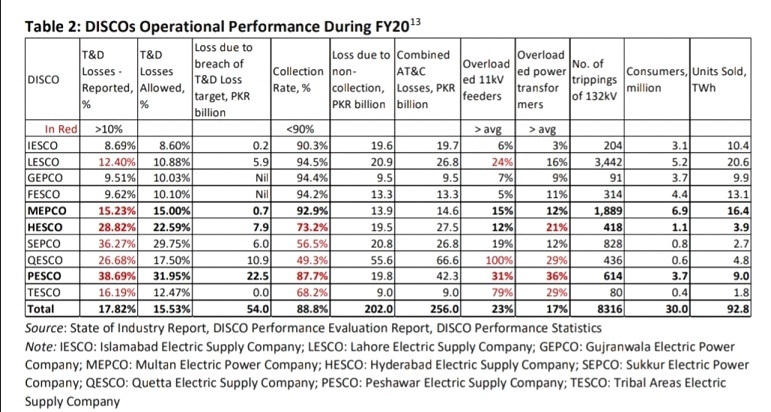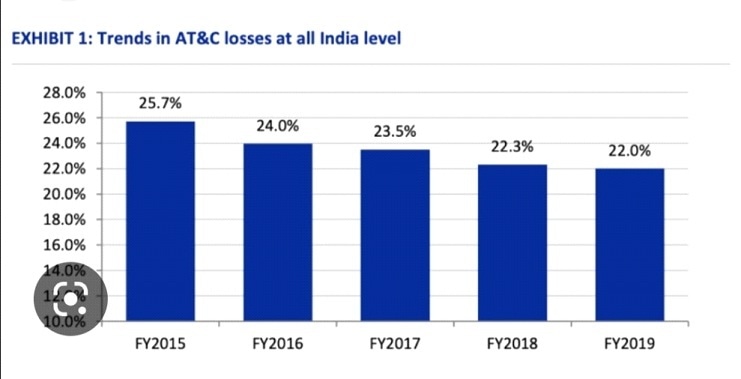T&D losses have been valued at Rs 520 billion. If losses are reduced to Nepra’s (National Electric Power Regulatory Authority’s) target level, there would be a saving of Rs 122 billion. If T&D losses are brought to a level of 10%, there would be an annual saving of Rs 215 billion. Combined with improved recovery potential saving of Rs 115 billion, total saving potential comes out to be Rs 330 billion.
We would like to correct a tendency in popular circuits of estimating total loss value and calling it saving potential. As discussed, there is a limit to loss reduction. We are not discounting here NTDC (National Transmission and Dispatch Company) transmission losses, as its scope and impact of savings is not significant.
No serious effort appears to have been made towards reduction of the T&D losses. There was a USAID project of DISCO improvements in 2007-2014, which did a lot of effort and made some key recommendations. The project installed demonstration/pilot projects involving Smart Meters in PESCO, MEPCO and HESCO. Later on in 2014, ADB (Asian Development Bank) developed an ill-designed Smart Meters(SM) project for better performing DISCOs like IESCO and LESCO. One could not understand the logic behind selection of these companies; while ignoring the worst-performing companies where pilot projects had already been launched earlier by USAID project, professional jealousy or what?
Power distribution sector’s performance – I
Another problem with smart meter project’s design is the proposal of installing SM at consumer premises. There are 35 million consumers, which would cost 5-7 billion USD and 7-10 years to install. An alternative project design could be SM installation at Distribution Transformers (DTs), which would have cost lesser time and money around 500 million USD. The issue continued to be debated between lender and the borrower. Fortunately, an agreement has been reached on an optimal and prioritized project design.
It is hoped that SM project would be completed in three years or less. Governance issues may still remain as SM project can be resisted and destroyed by the chieftains and Mafias. If DTs can be stolen and installed at locations of choice, what can possibly be done? The technique is of isolating high theft areas through DT and Transformer input and output (sales/bills) analysis. One can then apply increased vigilance and inspections to identify real culprits. Smart meters can then be selectively installed in such cases. KE has worked on such a scheme and has achieved success.
The kunda culture

Unauthorized connections and theft have been done classically through kundas and tampering with meters. There has been much talk about installing cables, which are technically called ABC (Aerated Bundled Cables). PESCO and MEPCO had announced programmes for installation of these cables. ABCs help fight kunda connections due to covering as opposed to bare conductors employed normally. These are a bit expensive but have been quite successful. An added advantage is safety preventing electrocution and other incidents.
KE has reported some success in installing ABCs in problem areas. How much implementation has been done in DISCOs is not known. KE invested 50 million USD through a loan programme. High-loss DISCOs such as PESCO, MEPCO, HESCO, SEPCO and QESCO certainly need this kind of installation. There are other requirements such as conductor sizing and distribution transformer improvement that may help in reducing technical and non-technical losses.
Readers may think that I am justifying the ills and inefficiency of power sector in Pakistan. India is much better than us on several accounts in this area; its generation cost is less; it has much high local content both in equipment, materials and fuel. General technology level is higher. While we will take up some technical issues later, we would like to make a recommendation that may work in both countries; increase minimum wages significantly, doubling in less than three years and continuing the trend into the future. This would enable the poor to buy some energy at international prices. Before, achieving the afore-mentioned, reducing cross subsidies and leakage are not possible. In the aftermath of Covid, floods, war in Europe, international energy crisis and high prices, recession and, particularly, heavy currency devaluation in Pakistan are the factors that must be appreciated by the IMF (International Monetary Fund) and other institutions. It does not mean that the federal government cannot do an thing; it can collect taxes from the powerful of one sort or the other. It may be argued that an increase in minimum wages may take time, but then so should the energy tariff increase agenda. This requires growth and employment and collection of revenues.

Regulator’s Role and Responsibilities
Many DIPs (dual in-line packages) have been launched in the past with technical and financial assistance of ADB and USAID. How successful these have been? The glass is half full and half empty. Aid programmes have their own problems and peculiarities with large overheads and project design issues. Success depends on recipients as well. Nepra could do well to launch a DIP focusing on T&D loss reduction and tariff incentives thereof and specifying activities and improvements.
Nepra currently feels contented with giving targets of loss reduction and recovery. It is not enough. Ogra (Oil and Gas Regulatory Authority) has launched a similar programme which has had a reasonable success in at least one of the Gas DISCOs.

Organisational issues
There is a role for ministry in policymaking issues of the sector and inter-sectoral and inter-ministerial coordination and dealing with international financial bodies and other international agencies. It is in itself a large agenda. Boards have been formed and their role has been emphasized and these have been encouraged to do more than fiduciary responsibilities.

Neither do boards have improved their performance, nor do ministries let the boards operate independently with deeper involvement in company policy and performance issues. It is often argued that boards are not selected on merit. Engineering and sectoral experts argue that it is only they who are entitled to be on the boards. They seem to discount other professionals’ inputs such as those belong to finance, law and management.





PEPCO was disbanded and boards were brought into the picture expecting that this would work. It hasn’t. One may argue that the ‘glass is half or full’ syndrome may be there. It is alleged that PEPCO became just another bureaucratic layer without much value-addition. After board’s lack of success, it was thought that reviving PEPCO in an improved form and agenda could be a good idea. However, a confused organization has been founded, which could not start functioning after two years of the founding decision. In India, there is a highly competent body like CEA (Central Electric Authority) that provides all technical input and guidance to the electrical power sector. In Pakistan, we need to have a similar body.
(Concluded)
Copyright Business Recorder, 2023
The writer is former Member Energy, Planning Commission and author of several books on the energy sector

























Comments
Comments are closed.